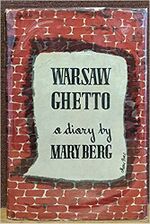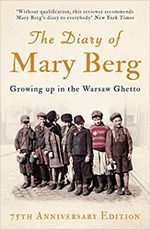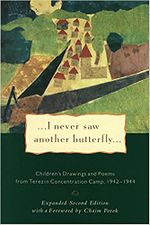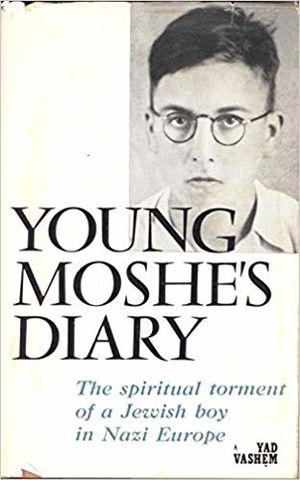Category:Holocaust Children's Diaries (subject)
Holocaust Children's Diaries
1940s
1945
The Diary of Mary Berg: Growing up in the Warsaw Ghetto (1945) is a diary written by Holocaust survivor Mary Berg (Miriam Wattenberg, 1924-2013) in the years 1939-1944 (age 15-19), when living in the Warsaw Ghetto. Published in New York, NY: Fisher, 1945, under the title Warsaw Ghetto: A Diary.
The diary of Miriam Wattenberg (“Mary Berg”) was one of the first children's journals which revealed to a wider public the horrors of the Holocaust.
"Inspiring and fascinating tale of the strength of human spirit during one of humanity’s darkest hours; • Reminiscent of both The Diary of Anne Frank, A Woman in Berlin and Suite Francaise; • Beautifully packaged in an attractive hardback, gift format for the Christmas market and containing original photographs and maps; • A unique insight from one of the few survivors of the Warsaw Ghetto, offering the only contemporary eye-witness account. After 60 years of silence, The Diary of Mary Berg is poised at last to gain the appreciation and widespread attention that it so richly deserves, and is certain to take it’s place alongside The Diary of Anne Frank as one of the most significant memoirs of the twentieth century. From love to tragedy, seamlessly combining the everyday concerns of a growing teenager with a unique commentary on life in one of the darkest contexts of history. This is a work remarkable for its authenticity, detail, and poignancy. But it is not only as a factual report on the life and death of a people that The Diary of Mary Berg ranks with the most noteworthy documents of the Second World War. This is the personal story of a life-loving girl’s encounter with unparalleled human suffering, a uniquely illuminating insight into one of the darkest chapters of history. Mary Berg was imprisoned in the ghetto from 1940 to 1943. Unlike so many others, she survived the war, rescued in a prisoner-of-war exchange due to her mother’s dual Polish-American nationality. Her diary was published in 1945 when she was still only 19, in an attempt to alert the world to the Nazi atrocities in Poland, when it was described as "one of the most heartbreaking documents yet to come out of the war" by the /New Yorker/. After the war, Berg remained in America in quiet anonimity."--Publisher description.
Mary Berg (Miriam Wattenberg, 1924-2013) was born Oct 10, 1924 to a Polish-Jewish father and and American-Jewish mother. They lived in Lódz but fled to Warsaw after the beginning of the war in November 1940. They were soon confined in the Warsaw ghetto. The Wattenbergs survived only because Miriam's mother was a US citizen. In the Summer of 1942 they were detained in the Pawiak prison, shortly before the first large deportation of Warsaw Jews to Treblinka. In January 1943 (three months before the Jewish revolt of the Ghetto) the Wattenbergs were sent to the Vittel internment camp in France, and allowed to emigrate to the United States in March 1944. After the publication of her diary, for a while Mary became a very vocal and popular figure in the anti-Nazi movement. When the war was over, however, Mary decided to live a private live, refusing to participate publicly in any Holocaust-related events, untile her death in April 2013.
1947
The Diary of a Young Girl (1952) is the first English edition of a diary written by Holocaust victim Anne Frank (1929-1945) in 1942-44 (age 13-15), while living in hiding in Amsterdam, Netherlands. First published in the Netherlands (Amsterdam, 1947).
Published in more than 70 languages. Adapted several times to the stage and to the screen.
The Diary of Anne Frank is by far the most famous among the children's diaries of the Holocaust and one of the world's best known books of the twentieth century. It was written in 1942-44, while Anne and her family were in hiding in Amsterdam.
Anne's father, Otto was the only survivor of the Franks. He returned to Amsterdam after the war to find that Anne's diary had been saved by his secretary, Miep Gies, and his efforts led to its publication in 1947. It was translated from its original Dutch version and first published in English in 1952 as The Diary of a Young Girl, and has since been translated into over 70 languages.
"Discovered in the attic in which she spent the last years of her life, Anne Frank’s remarkable diary has become a world classic—a powerful reminder of the horrors of war and an eloquent testament to the human spirit ... In 1942, with the Nazis occupying Holland, a thirteen-year-old Jewish girl and her family fled their home in Amsterdam and went into hiding. For the next two years, until their whereabouts were betrayed to the Gestapo, the Franks and another family lived cloistered in the “Secret Annexe” of an old office building. Cut off from the outside world, they faced hunger, boredom, the constant cruelties of living in confined quarters, and the ever-present threat of discovery and death. In her diary Anne Frank recorded vivid impressions of her experiences during this period. By turns thoughtful, moving, and surprisingly humorous, her account offers a fascinating commentary on human courage and frailty and a compelling self-portrait of a sensitive and spirited young woman whose promise was tragically cut short."--Publisher description.
Anne Frank (1929-1945) was born in Frankfurt, Germany, on June 12, 1929. She lived most of her life in or near Amsterdam, Netherlands, having moved there with her family at the age of four and a half when the Nazis gained control over Germany. In May 1940 Nazi Germany occupied the Netherlands and the persecution began. The Franks lost their German citizenship in 1941 and thus became stateless. As persecutions increased in July 1942, the Franks went into hiding in some concealed rooms behind a bookcase in the building where Anne's father, Otto Frank, worked. They lived there until the family's arrest by the Gestapo in August 1944. Following their arrest, the Franks were transported to concentration camps. In October or November 1944, Anne and her sister, Margot, were transferred from Auschwitz to Bergen-Belsen concentration camp, where they died (probably of typhus) a few months later, probably in February 1945.
1950s
1959
I Never Saw Another Butterfly: Children's Drawings and Poems from the Terezin Concentration Camp (1959) is the English ed. of an anthology of children's drawings made by children of the Terezin Concentration Camp in the years 1942-1943. Originally published in Czech (1959)
"A selection of children's poems and drawings reflecting their surroundings in Terezín Concentration Camp in Czechoslovakia from 1942 to 1944. Fifteen thousand children under the age of fifteen passed through the Terezin Concentration Camp. Fewer than 100 survived. In these poems and pictures drawn by the young inmates, we see the daily misery of these uprooted children, as well as their hopes and fears, their courage and optimism. 60 color illustrations."--Publisher description.
Published in Praha: Museo Statale Ceco, 1959). Originally published in Czech (Prague: Museo statale ceco, 1959). Reprinted in New York: McGraw-Hill, 1962, and 1978. 2nd enlarged ed. by the United States Holocaust Memorial Museum (New York : Schocken Books, 1993).
Also published in German (1959), French (1959), Hebrew (1963), and other languages
1960s
1965
Young Moshe's Diary: The Spiritual Torment of a Jewish Boy in Nazi Europe (1965) is the English ed. of a diary written by Holocaust victim Moshe Flinker (1926-1944) in the years 1942-1943 (age 15-17), when living in hiding in Brussels, Belgium with his family.
Abstract
"Moshe Flinker died in Auschwitz but he left copy books describing his innermost thoughts during the fateful days prior to his deportation. His surviving sisters rescued his writings from the cellar of the house in which they had all hid. In his unnatural underground existence he did not fully realize the methodical extermination being perpetrated by the Nazis, but he came very near in a remarkable portrayal of the Jewish situation, which he recorded in January 1943."--Publisher description.
"Moshe Flinker was a sixteen-year-old Jewish boy whose family had fled from Holland to Belgium in an attempt to avoid deportation to the east. During this period of hiding and flight, Moshe was no longer able to go to school or to engage in the activities of normal life. In an attempt to stave off idleness, he decided to begin a diary. Moshe used his diary to record the experiences that his family faced in their struggle to endure Nazi persecution. He also wrestled continuously with the question of why this suffering plagued the Jewish people. On November 30, 1942 he wrote, “Now I return to the question mentioned above and its solution: what can God mean by all that is befalling us and by not preventing it from happening? This raises a further question, which must be settled before we can proceed further with the main problem. This second question is whether our distress is part of the anguish that has afflicted the Jewish people since the exile, or whether this is different than all that has occurred in the past. I incline to the second answer, for I find it very hard to believe that what we are going through today is only a mere link in a long chain of suffering.” Moshe was a deeply religious young man and he sought to understand his present circumstances in the light of biblical history. He looked for insight from the persecutions of the past and longed for God’s promised redemption of the Jewish people. He believed that this deliverance would come when the conditions were right, both in the severity of persecution and in the responses of the victims. Much of his diary was dedicated to this type of analysis. He concluded his November 30th entry with these words, “I should like to pray to the Lord of Israel that He may fulfill in the near future the prayer: ‘Return us unto thee, O Lord, and we shall return; renew our days as of old.’’--Holocaust Center of Florida.
Published in Jerusalem [Israel]: Yad Vashem, 1965. Originally published in Hebrew (Jerusalem [Israel]: Yad Vashem, 1958).
Also published in Russian, Dutch, German, French, Italian, and Yiddish.
Moshe Flinker (1926-1944) was born in The Hague on October 9, 1926, and was raised in an Orthodox Jewish home. After being subjected to increasingly restrictive anti-Jewish measures following the German occupation of the Netherlands in 1940, the Flinker family fled to Belgium in 1942. In Belgium, Moshe and his family were able to pass as non-Jews with the help of false identity papers and relative anonymity ... Moshe was a deeply religious young boy who grappled with the theological problems posed by the unprecedented persecution of the Jews. He was also a gifted linguist who knew and studied eight languages, including Arabic, which he saw as fundamental to his future life in Palestine ... In April 1944, after being betrayed by a known Belgian Jewish collaborator, Moshe, his mother, and his sisters Esther Malka and Leah, were arrested at their home and deported to Malines. His father, tipped off by a neighbor, prevented Moshe’s four other siblings from going home and arranged for them to find refuge in the Tieffenbrunner orphanage near Antwerp ... Two weeks later, Moshe’s father was caught and sent to Malines, where he found his family. They were all deported to Auschwitz-Birkenau in May 1944. Moshe’s mother, Mindel, was murdered on arrival. Esther Malka and Leah remained in the women’s camp ... Moshe and his father spent several months in Auschwitz-Birkenau before they were transferred to Echterdingen labor camp, where they both contracted typhus. From there, they were sent to Bergen Belsen, where they both succumbed to typhus in January 1945 ... Esther Malka and Leah survived Auschwitz-Birkenau and were reunited with their four siblings in Brussels after the liberation. They all emigrated to Israel.
Pages in category "Holocaust Children's Diaries (subject)"
The following 30 pages are in this category, out of 30 total.
1
- Sarah Fishkin (F / Belarus, 1924-1942), Holocaust victim
- Ilya Gerber (F / Lithuania, 1924-1943), Holocaust victim
- Dawid Sierakowiak (M / Poland, 1924-1943), Holocaust victim
- Renia Spiegel (F / Poland, 1924-1942), Holocaust victim
- Moshe Flinker (M / Netherlands, 1926-1944), Holocaust victim
- Clara Kramer (F / Poland, 1927-2018), Holocaust survivor
- Dawid Rubinowicz (Poland, 1927-1942), Holocaust victim
- Yitskhok Rudashevski (M / Lithuania, 1927-1943), Holocaust victim
- Jutta Szmirgeld / Jutta Bergman (Germany, Poland, 1927)
- Otto Wolf (M / Czechia, 1927-1945), Holocaust victim
- Lilly Cohn / Lillyan Rosenberg (F / Germany, 1928), Holocaust survivor
- Vera Diament / Vera Gissing (F / Czechia, 1928), Holocaust survivor
- Leo Silberman (M / Poland, 1928-2015), Holocaust survivor
- Susi Hilsenrath
- Vera Kohnova (F / Czechia, 1929-1942), Holocaust victim
- Rutka Laskier (F / Poland, 1929-1943), Holocaust victim
- Rywka Lipszyc (F / Poland, 1929-1945), Holocaust victim
- Helga Weiss / Helga Hošková-Weissová (F / Czechia, 1929), Holocaust survivor
- Michal Kraus (M / Czechia, 1930), Holocaust survivor
- Éva Heyman (F / Hungary, 1931-1944), Holocaust victim
- Jerzy Feliks Urman (Poland, 1932-1943), Holocaust victim
- I Never Saw Another Butterfly: Children's Drawings and Poems from the Terezin Concentration Camp (1959 @1959 Volavková), anthology
- Ruthka: A Diary of War (1993 Lieblich), book
- Children in the Holocaust and World War II: Their Secret Diaries (1995 Holliday), anthology
- We Are Children Just the Same: Vedem, the Secret Magazine by the Boys of Terezín (1995 Krízková), anthology
- The Diary of Dawid Sierakowiak: Five Notebooks from the Lódz Ghetto (1996 Sierakowiak), book






